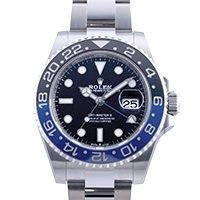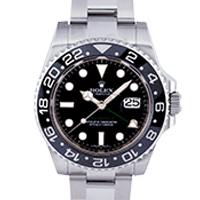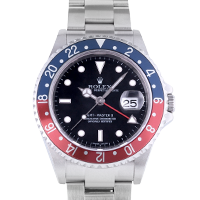GMTマスター(GMT MASTER)商品の歴史・年表で解説
History
GMTマスター(GMT MASTER) 商品の歴史・年表に関するご説明をいたします。初めての方でもわかりやすく商品に関して説明をしていきます。
GMTマスター(ロレックス)商品の歴史・年表で解説
| 2019年 | 70時間のパワーリザーブ、クロナジーエスケープメント機構をもつCal.3285を搭載した新しいバットマンが登場。 |
|---|---|
| 2018年 | Ref.126715CHNRのエバーローズゴールドのモデルが登場。10の項目で特許を取得した新キャリバーCal.3285を搭載したRef.126710BLROが登場。 |
| 2014年 | 青赤ベゼルの通称“ペプシ”、Ref.116719BLROが登場。 |
| 2013年 | Ref.116710BKNRが登場。青黒の組み合わせはGMTマスターでは初めてであり、“バットマン”としてヒットする。 |
| 2005年 | GMTマスター50周年の記念としてデザインを刷新、ケースサイズのアップやブラックベゼルを採用。 |
| 1989年 | シリーズ2代目となるRef.16710が登場。1999年まで製造されるロングセラーとなる。 |
| 1988年 | サファイアクリスタル風防を採用したRef.16700が登場。最後のGMTマスターモデルとなる。 |
| 1982年 | 初代GMTマスターⅡのRef.16760が登場。“ファットレディー”、“ソフィアローレン”の愛称を持つ。 |
| 1980年 | Ref.16750が登場、Cal.3075を搭載し、赤青に黒のベゼルが加わった。 |
| 1967年 | “ピンクパンサー”ベゼルが1年間のみ製造される。 |
| 1965年 | Ref.1675/3“ルートビア”が登場。 |
| 1959年 | りゅうずガードを付けたRef.1675が登場。 |
| 1955年 | パイロット用に初代GMTマスターのRef.6542が登場。 |
GMTマスターの系譜
取扱ブランド
- ROLEX
ロレックス Cartier
カルティエ OMEGA
オメガ PATEK PHILIPPE
パテック・フィリップ AUDEMARS PIGUET
オーデマ・ピゲ Breguet
ブレゲ ROGER DUBUIS
ロジェ・デュブイ A.LANGE & SOHNE
ランゲ&ゾーネ HUBLOT
ウブロ FRANCK MULLER
フランク・ミュラー CHANEL
シャネル HARRY WINSTON
ハリー・ウィンストン JAEGER LE COULTRE
ジャガー・ルクルト IWC
IWC PANERAI
パネライ BREITLING
ブライトリング TAG HEUER
タグ・ホイヤー Van Cleef & Arpels
ヴァンクリーフ&アーペル HERMES
エルメス Chopard
ショパール ZENITH
ゼニス DAMIANI
ダミアーニ TUDOR
チューダー(チュードル) TIFFANY&Co.
ティファニー PIAGET
ピアジェ BOUCHERON
ブシュロン BVLGARI
ブルガリ RICHARD MILLE
リシャール・ミル




